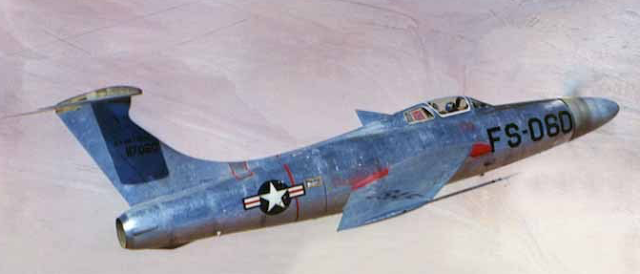I first read of the Navy's prospective involvement in the program in the 3 May 1954 issue of Aviation week, which stated that the XF-84H was to fly in August. It also stated "the Air Force will use the plane to check supersonic propeller characteristics" and, of more interest to me, after being "fitted with another type Aeroproducts propeller, it will also undergo Navy carrier trials".
As it happened, it didn't fly until July 1955 and there was no Navy testing. In fact, there was very little Air Force testing, since the two XF-84Hs only flew a total of 12 times, making precautionary landings on 11 of those occasions. As a test-pilot friend of mine once noted, it doesn't take long to take a close look at a hot horseshoe.
I had assumed that the Navy's interest in the airplane, if true, had been as a backup for the Douglas A2D Skyshark, which was powered by the same Allison T40 turboprop engine.
However, the timing was way off, the XA2D having first flown in May 1950. Also, its engine was more or less unsatisfactory from the get-go, suggesting that the Navy's backup for the A2D, if it had one, would have used a different one.
I just now took another look at the XF-84H program since Steve Ginter has released the latest in his excellent series of monographs on Navy and Air Force aircraft.
To order from Steve (he makes a few more bucks that way) see http://www.ginterbooks.com/AIRFORCE/AFL219.htm
There aren't many details about the Navy's involvement, but by happenstance, John M. Leonard updated his fascinating online article (http://www.enginehistory.org/Allison/XF-84Propulsion.html) about the XF-84H propulsion system for the latest issue of the American Aviation History Society Journal (Fall 2015). If you're not a member, you should be. This issue alone is worth the price of a year's subscription.
He describes what little is known about the Navy involvement, which was basically the funding of design and whirl test of an Aeroproducts six-bladed, two-row propeller beginning in late 1949 or early 1950. This is a picture from his AAHS article:
The aft (bottom, as depicted here) propeller is obscured in this picture. The propellers were nine feet in diameter and separated by about 18 inches longitudinally. The aft propeller was offset by 15 degrees and, surprisingly, given the amount of torque involved, rotated in the same direction. I assume that the shock waves from the front propeller dictated this configuration.
In the late 1940s and early 1950s, the Navy was interested in a supersonic propeller in order to get more range and endurance from a fighter with with jet performance, not to mention the takeoff and wave-off benefits of the propeller.
As far as I know, the Navy never got as far as assigning a Bureau Number to its AP-46, which would have been the third one built. Instead, the Air Force reportedly agreed to install the Navy gearbox and propeller in the second XF-84H after its initial flight test. That, of course, didn't happen.
* Seversky did propose a carrier-based variant of its P-35 to the Navy in 1937 and furnished one, free of charge, for an evaluation that included the Brewster F2A Buffalo and the Grumman F4F Wildcat. Seversky promoted it as "NF-1", signifying Navy fighter number one, but it was civil registered and as far as I know, not assigned a Bureau Number or Navy designation. For one thing, it was on loan from Seversky and not owned by the Navy. The Navy reportedly referred to it as the XFN-1. This is possible—albeit only informally since the designation had previously been assigned to a Naval Aircraft Factory fighter, BuNo A8978, several years before and the Navy rarely reused a designation even when, as in this case, the NAF design wasn't built. According to several websites, the P-35 evaluated by the Navy was modified by the Naval Aircraft Factory and therefore designated XFN-1; I suspect that this is a conflation of the two designations leading to an erroneous conclusion. For one thing, the Grumman XF4F-3 was assigned BuNo 0383 and the Brewster XF2A-1, 0451. If the NAF did modify the P-35 and it was assigned a BuNo, it would have almost certainly been higher than 0451, not 1,400 BuNos lower in the previous A series.



















